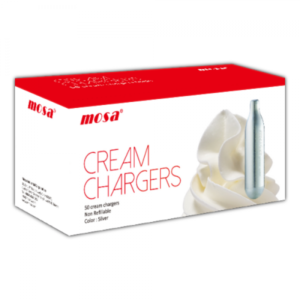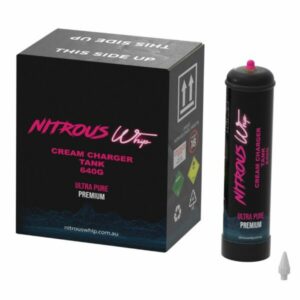
Eco-Friendly Alternatives to Traditional Cream Charger Usage
Introduction
In a world that is becoming significantly knowledgeable about ecological problems, the food service market is not far behind. One such area ripe for innovation is the use of cream chargers Generally made from metal and filled with nitrous oxide (N2O), these small canisters have actually been a staple in kitchen areas for producing whipped cream and other culinary thrills. However, as we look for eco-friendly options to standard cream battery charger use, it's important to check out sustainable alternatives that minimize our environmental footprint while still delivering the preferred results in our recipes.
The phrase "Eco-Friendly Alternatives to Conventional Cream Battery charger Use" encapsulates a significant transition towards greener practices. In this article, we'll dive deep into different elements of cream chargers, including their ecological impact, alternative techniques for attaining similar outcomes, and innovative technologies that are redefining the whipped cream experience.
Understanding Cream Chargers
What are Cream Chargers?
Cream chargers, typically described as whipped cream chargers, are little cylinders including laughing gas gas. They work by releasing gas into a whipped cream dispenser, which produces a light and airy texture ideal for toppings or desserts.

How Do Whipped Cream Chargers Work?
When you insert a cream battery charger bulb into a suitable whipped cream dispenser and press the lever, the N2O gas quickly expands and combines with liquid cream. This procedure not only aerates the cream but also increases its volume significantly.
Types of Cream Chargers
- N2O Cream Chargers: The most typical type utilized in kitchens.
- Nitrous Oxide Cream Chargers: A more technical term for N2O chargers.
- Cream Charger Bulbs: The individual units which contain nitrous oxide.
- Nangs or Nossies: Slang terms used mainly in specific regions.
Environmental Impact of Conventional Cream Chargers
Metal Waste Concerns
The production and disposal of metal-based cream chargers contribute considerably to ecological degradation. Many chargers are made from aluminum or steel, both of which require considerable energy to produce and can lead to considerable waste when discarded improperly.
Greenhouse Gas Emissions
The nitrous oxide gas itself has a high worldwide warming capacity, making standard use problematic in an age where reducing emissions is critical.
Recycling Challenges
Although many metal chargers can technically be recycled, they often end up in land fills due to inappropriate disposal practices.
Eco-Friendly Alternatives to Standard Cream Charger Use
Plant-Based Whipping Agents
One practical option consists of utilizing plant-based whipping agents made from ingredients like coconut milk or aquafaba (the liquid from chickpeas). These options provide comparable whipping abilities without counting on damaging gases.
Benefits of Plant-Based Options
- Lower carbon footprint
- No reliance on metal containers
- Vegan-friendly
Manual Whipping Techniques
Using tools such as a whisk or electric mixer offers an environmentally friendly way to whip cream without introducing waste through gas battery chargers. It needs more effort however leads to zero environmental effect from item waste.

Pros & Cons
|Pros|Cons|| ------------------------------|--------------------------|| Zero waste|Needs physical effort|| Economical|Time-consuming|
Reusable Whipped Cream Dispensers
Investing in multiple-use dispensers permits you to bypass single-use chargers altogether. These can be filled with homemade whipped creams made from natural active ingredients without any included gases.
Why Go Reusable?
Innovative Technologies in Food Preparation
Gas Pressure Regulators
Modern kitchen area gizmos geared up with gas pressure regulators allow you to control the quantity of gas introduced throughout whipping processes successfully. This lowers waste while still providing the fluffy texture expected from standard methods.
Advantages of Advanced Technology
Exploring Alternative Gases for Whipped Cream Production
While nitrous oxide remains popular, some innovators are explore other gases that may provide less hazardous influence on the environment.
Carbon Dioxide (CO2)
Though not usually utilized for whipped cream, CO2 has possible applications in cooking foam productions and might work as an alternative gas option cream charger tank supplier recommendations if innovation develops further.
Is CO2 a Viable Option?
The answer depends on ongoing research study around food safety and texture quality when using co2 rather of nitrous oxide.
Sourcing Sustainable Ingredients
To complement your eco-friendly whipped cream practices, consider sourcing organic and in your area produced components whenever possible.
Local Dairy Farms vs Industrial Production
Choosing local providers minimizes transport emissions while supporting community farming efforts-- a necessary element of sustainable eating habits.
How Does Local Sourcing Help?
FAQs About Eco-Friendly Alternatives to Traditional Cream Battery Charger Use
1. What are eco-friendly options to traditional cream chargers?
There are several alternatives including plant-based whipping representatives like coconut milk or aquafaba, manual whipping strategies using whisks or electric mixers, and multiple-use whipped cream dispensers that remove single-use items entirely.
2. Can I make whipped cream without utilizing any kind of charger?
Absolutely! You can whisk heavy or whipping cream by hand until it forms peaks; this technique needs no extra devices beyond basic cooking area tools.
3. Are there any health concerns concerning standard N2O use?
While laughing gas is generally safe for cooking usages when handled correctly, excessive direct exposure can lead to health dangers consisting of dizziness or impaired coordination if misused outside intended applications.
4. How do recyclable dispensers work?
Reusable dispensers typically come equipped with tools permitting users to create homemade whipped creams without counting on external gases-- providing greater control over active ingredients while reducing waste generation!
5. What's wrong with standard metal chargers?
Traditional metal chargers contribute substantially toward land fill waste due both their production procedures needing energy-intensive products like aluminum & & steel in addition to incorrect disposal practices leading them winding up discarded instead of recycled effectively!
6 Can I utilize other gases instead of nitrogen oxides?
While there's continuous experimentation around different gases-- like co2-- the culinary market mainly counts on nitrous oxides due their efficient capability aerate liquids quickly; research study continues into checking out more secure options however!
Conclusion
As we browse through an era focusing on sustainability at every level-- from individual choices down industry-wide practices-- it becomes significantly vital that we reassess traditional approaches like those surrounding standard cream battery charger use! By welcoming environment-friendly options such as plant-based items & & manual strategies together with innovative technologies developed reduce waste yield positive outcomes not only environmentally however also economically!

Let's devote ourselves towards reducing our carbon footprints together by making conscious decisions today about how we prepare delicious deals with tomorrow! After all-- every bit counts when it comes maintaining planet Earth for future generations! So why not check out these exciting alternatives now?
This comprehensive expedition aims at assisting readers through understanding both the need & & excitement around turning towards greener alternatives within culinary arts specifically focusing upon beloved items like whipped creams produced making use of various means beyond mere dependence upon conventional methods alone! Let's make it happen!